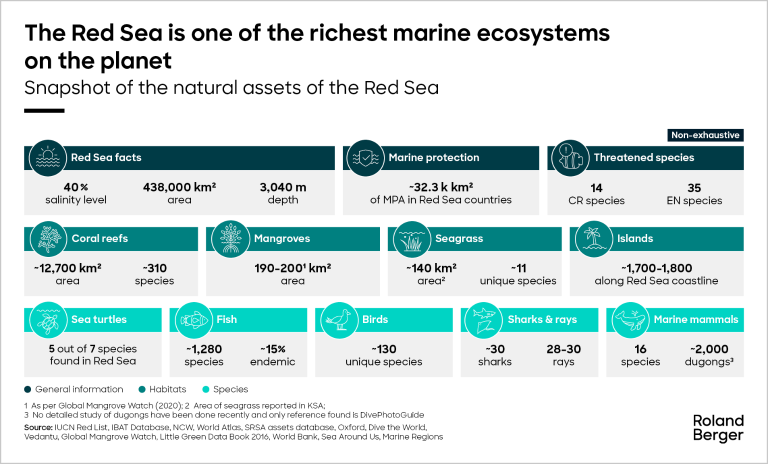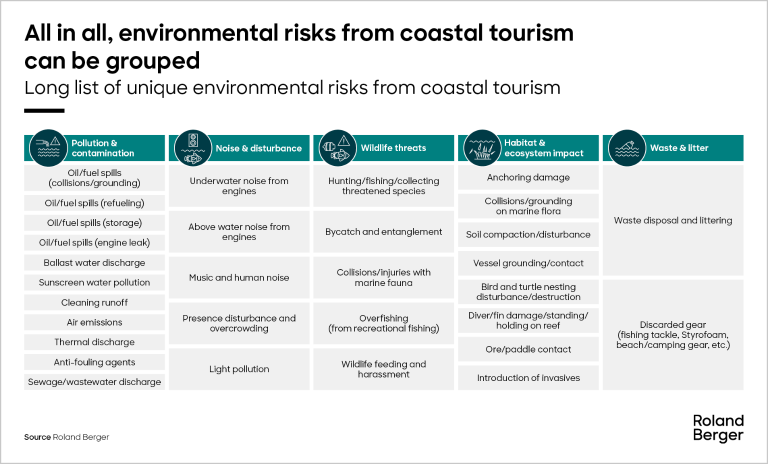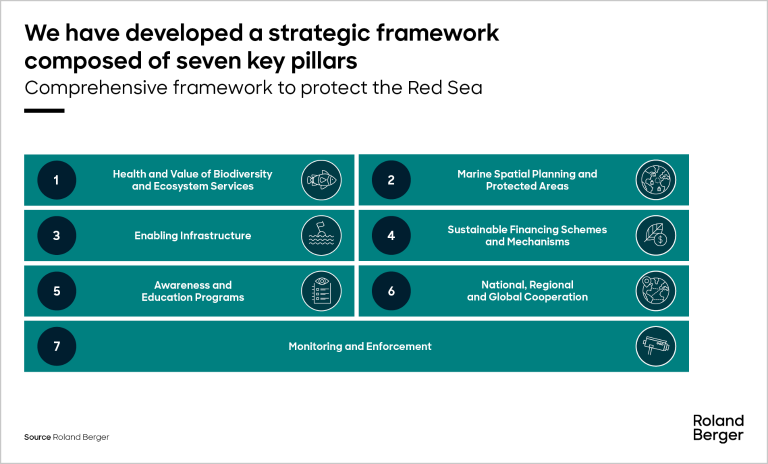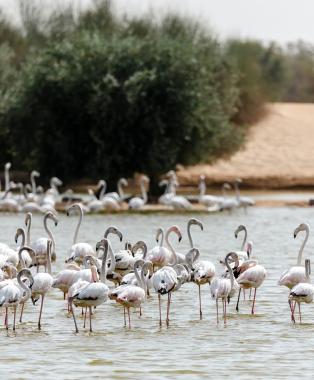This publication by Roland Berger, in partnership with Emirates Nature-WWF, presents a five-step valuation approach for assessing the true costs and benefits of planned developments in the UAE's coastal lagoons. The report focuses on ecosystem services such as carbon sequestration, coastal protection, fisheries, and aesthetics, and highlights the potential of ecotourism as a promising scenario for increasing ecosystem services over time.


Balancing conservation and growth - A framework for protecting Red Sea biodivers
By Karim Haggar
Leveraging sustainable development to preserve a unique marine ecosystem
The Red Sea is one of the world's most biodiverse marine environments, stretching over 2,250 kilometers and bordered by several countries. Its unique ecosystems, including coral reefs, mangroves, and seagrass beds, provide essential services to local communities and economies, such as tourism, fishing, and coastal protection. However, the rapid economic development in this region poses significant challenges to the conservation of its marine biodiversity. Striking a balance between economic growth and environmental protection is crucial to ensure sustainable development for the region.
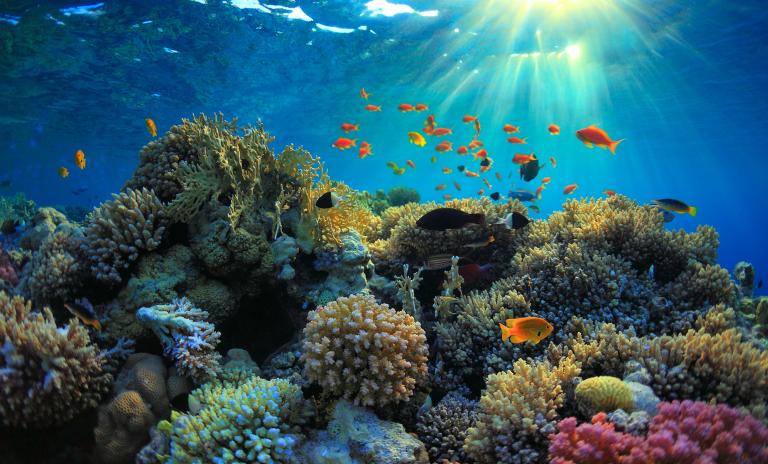
The Red Sea's unique biodiversity
The Red Sea is home to over 1,200 species of fish, 10% of which are found nowhere else on Earth. The region's coral reefs are particularly noteworthy, as they exhibit remarkable resilience to climate change and warming waters. These ecosystems support various marine life forms and serve as critical nursery grounds for commercially valuable fish species. Moreover, the Red Sea's mangroves and seagrass meadows act as vital carbon sinks, playing a crucial role in climate regulation and supporting local fisheries.
However, these ecosystems are under threat from increasing coastal development, overfishing, pollution, and climate change. The challenge lies in protecting these valuable ecosystems while accommodating the growing demand for economic development driven by tourism, fishing, and shipping industries.
Economic development and environmental challenges
Economic development is vital for the countries bordering the Red Sea, with tourism being one of the key drivers. Tourists flock to these countries for diving, snorkeling, and other marine activities. However, the uncontrolled expansion of tourism infrastructure, such as hotels, resorts, and marinas, poses risks to marine habitats. These developments often lead to habitat destruction, pollution from runoff, and increased pressure on local resources.
Fishing is another essential economic activity in the region. However, unsustainable fishing practices have led to the depletion of fish stocks, threatening the livelihoods of local communities and the ecological balance of the Red Sea. Furthermore, pollution from shipping activities, oil spills, and coastal development contribute to the degradation of water quality and marine habitats.
International organizations have been instrumental in funding and supporting initiatives aimed at sustainable development in the Red Sea region. However, more collaborative efforts are needed between governments, NGOs, and the public and private sectors to ensure that economic activities are managed sustainably and that the marine environment is protected.
A comprehensive framework to protect the Red Sea
Protecting the unique marine environment of the Red Sea requires coordinated efforts from governments, local communities, international organizations, and individuals. Drawing on recent and ongoing conservation work in the Red Sea and similar marine and coastal ecosystems, the Roland Berger biodiversity team has developed a strategic framework composed of seven key pillars. This framework is designed to help governments and decision-makers balance economic development with conservation efforts, ensuring the sustainable growth of a blue economy.
- Health and value of biodiversity and ecosystem services: Understanding and monitoring the health of biodiversity is crucial. This involves conducting baseline assessments and ongoing surveys to evaluate the condition of habitats and species. Additionally, measuring the value of natural capital based on ecosystem services—both use and non-use services—provides insight into the economic importance of conservation. For example, a UNEP study estimates the global value of coral reefs at $2.7 trillion annually, with the Red Sea's coral reefs contributing approximately $160 billion each year.
- Marine spatial planning and protected areas: Developing a marine spatial plan (MSP) for the Red Sea coast is essential for managing the various sectors of the blue economy. This plan would map resource usage and create zoning plans, including carrying capacity studies to determine sustainable thresholds for activities such as tourism. The MSP should be aligned with conservation frameworks like the Kunming-Montreal Global Biodiversity Framework (GBF), which aims for 30% protection of land and sea areas by 2030.
- Enabling infrastructure: Sustainable infrastructure plays a vital role in reducing environmental threats. Measures such as deploying mooring buoys to prevent boats from damaging coral reefs and establishing waste management facilities in ports are practical steps toward protecting marine ecosystems. For instance, along the Egyptian Red Sea coast, a network of 1,000 mooring buoys has been implemented to safeguard the Great Fringing Reef.
- Sustainable financing schemes and mechanisms: Financing conservation and sustainable practices requires innovative approaches. Developing mechanisms like blue bonds, coral reef funds, and biodiversity credits can provide the necessary resources for new projects. The Global Fund for Coral Reefs is an example of a blended finance mechanism designed to mobilize $500 million for enhancing coastal reef ecosystems' resilience.
- Awareness and education programs: Education and outreach are key components in promoting sustainable interactions with marine environments. Awareness campaigns and educational programs tailored to different sectors of the blue economy can foster a culture of conservation. In Saudi Arabia, the Red Sea Authority has collaborated with the Khaled bin Sultan Living Oceans Foundation to promote sustainable marine tourism and provide scholarships for aspiring marine scientists.
- National, regional, and global cooperation: Effective conservation often requires collaboration across different levels and sectors. National, regional, and global partnerships, involving governments, the private sector, non-profit organizations, and local communities, are critical. The Red Sea's conservation efforts are supported by regional organizations like PERSGA, which has been working on biodiversity protection and marine pollution since 1982.
- Monitoring and enforcement: Robust monitoring and enforcement mechanisms are essential to ensure compliance with environmental regulations. Tools and resources should be deployed to monitor activities, detect potential risks, and prevent illegal actions that could harm the marine environment. In Saudi Arabia, oil spill monitoring along the Red Sea coast is managed by SAIL, a subsidiary of the Saudi Investment Recycling Company (SIRC), which employs advanced technologies and a dedicated fleet for swift response.
The path forward
Balancing marine conservation and economic development in the Red Sea requires a holistic approach that considers the needs of both nature and people. By implementing integrated management plans, promoting sustainable practices, and fostering regional cooperation, the Red Sea countries can protect their unique marine biodiversity while achieving sustainable economic growth. This will not only benefit the environment but also ensure the long-term prosperity and well-being of local communities.

